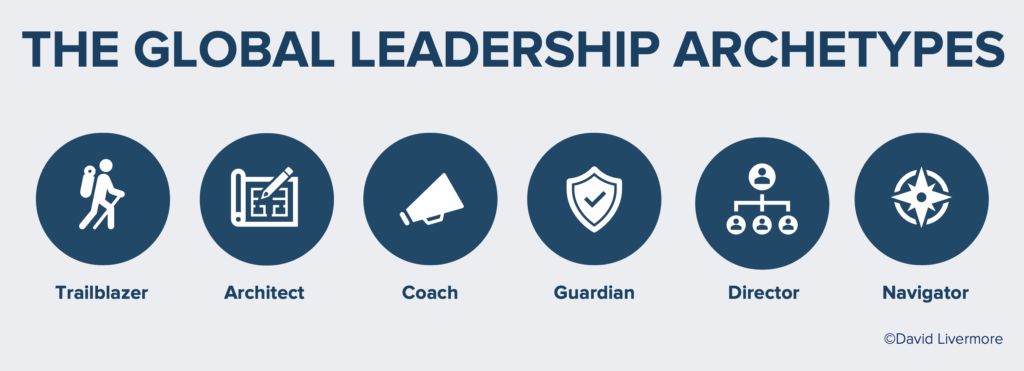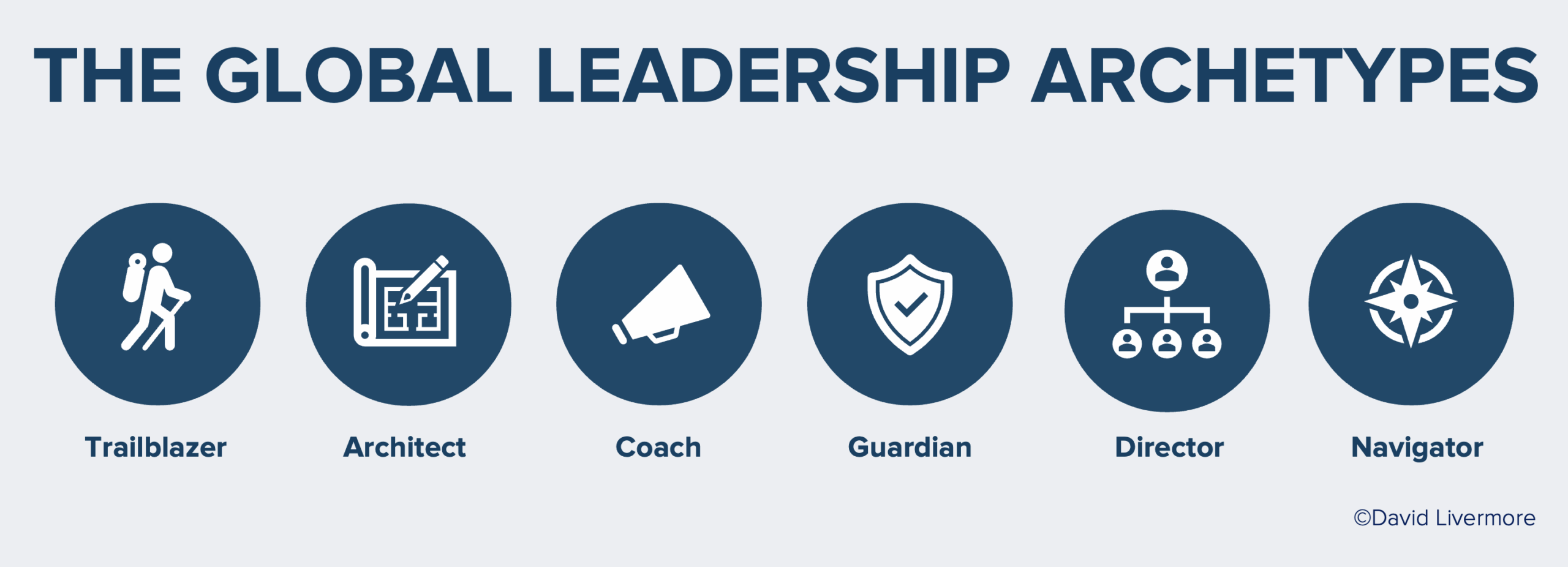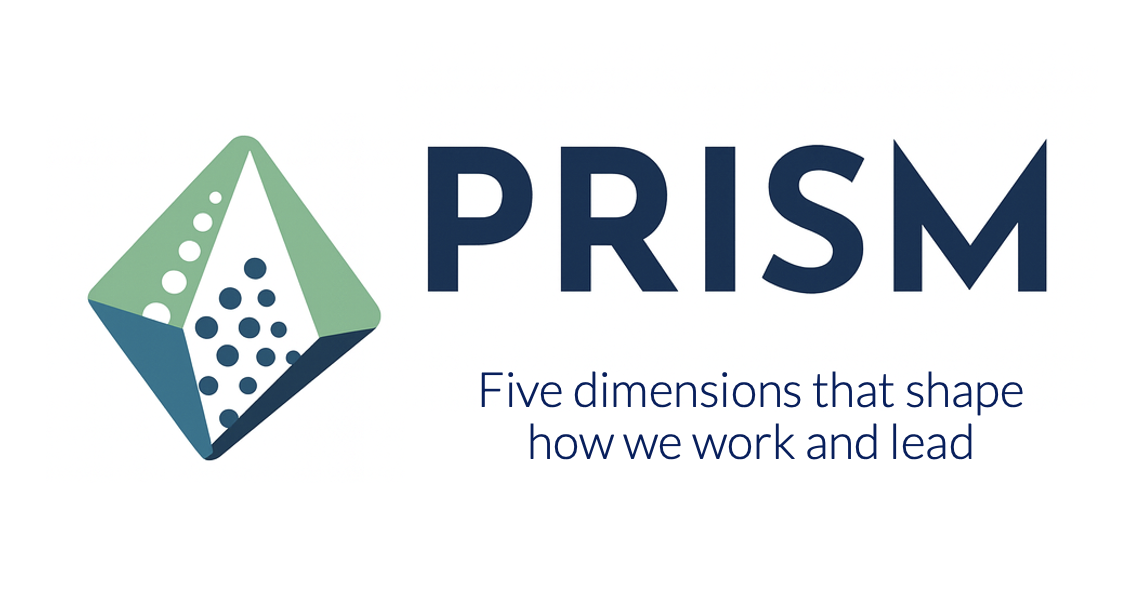
90 percent of leadership literature is biased toward one kind of leader—decisive, assertive, fast-paced, and individualistic. Yet most of the world prefers a different kind of leadership style. I’ve written extensively about this in Leading with Cultural Intelligence, Harvard Business Review, and in a variety of academic and practitioner articles. Now, I’m excited to share some new work that addresses this challenge.
Adapting how we lead is at the heart of leading effectively. And over the past four years, my colleagues and I have examined what effective leadership actually looks like across a diversity of teams and contexts. Drawing on data from every major region of the world, we uncovered six leadership archetypes that capture the dominant ways people lead. Our findings are currently in press, but I want to share an early look at what we discovered and what it means for leaders everywhere.
How the Six Archetypes Emerged
The six global leadership archetypes emerged from a multi-year study examining how workstyle differences shape collaboration and leadership. We set out to move beyond nationality and personality to explore the full range of forces that influence how we make decisions, communicate, and get work done including gender, ethnicity, profession, cognitive style, and organizational culture.
This research led us to identify five dimensions that most strongly affect how people collaborate at work—Power, Risk, Identity, Speed, and Messaging (PRISM). We developed and validated items to measure observable behaviors across each of these dimensions. You can read more about that process here.
As we analyzed the PRISM data, recurring patterns began to surface. Certain combinations of workstyle values consistently clustered together. For example, a preference for top-down leadership often coincided with collectivist norms, as seen in many Sub-Saharan African cultures (“Ubuntu!”) or military organizations (“All for one. Yes, sir!”). Likewise, speed is often linked with identity. Individualists tend to move faster and collectivists favor more deliberation.
We used cluster analysis to examine all the possible combinations of PRISM values, ranging from moderate to extreme. There were hundreds of potential configurations, but six appeared repeatedly across industries and regions. These clusters became the basis for the six leadership archetypes.
We then compared these six patterns to the broader literature on global leadership and mapped where each archetype tends to appear. Some are more prevalent in Western contexts and others in the Global South. The same holds true across different industries with some appearing more often in technology and finance and others in health care and education. Yet the most striking finding was that these six archetypes transcend nationality, ethnicity, generation, and industry. To state the obvious, not all Asians lead alike, nor do all Millennials. Yet that’s exactly how leadership differences are often portrayed.
The Six Leadership Archetypes
The six global leadership archetypes offer a more nuanced way to understand 21st Century leadership and teams, acknowledging the role of culture and identity without over-indexing on any single factor. Each archetype is measured in the new PRISM Leadership Profile, providing a missing link for applying cultural intelligence to leadership.
TRAILBLAZER | Lead with vision and momentum
Trailblazers are the kind of leaders who are most often featured in business magazines, leadership books, and management case studies. They lead with confidence and gravitas, they thrive on possibility, and they’re energized by uncharted territory. The Trailblazer is the prototypical US business leader, though even in the US, this leadership style is increasingly met with mixed reactions depending on the context. Trailblazers are great at forging new ground but they need CQ to ensure that their optimism and constant drive for innovation don’t leave teams overwhelmed or unheard.
ARCHITECT | Lead with structure and precision
Architects provide direction and leadership through systems and processes. Unlike trailblazers, they’re less likely to announce a new change by sharing a grandiose vision and are more likely to share a detailed account of how a change is going to take place. This style often thrives in engineering, legal, and operational environments and is common in many European companies. Team members that value reliability and predictability often flourish under Architects. But CQ becomes critical when an Architect is leading individuals who want to be inspired through vision, charisma, and possibility.
COACH | Lead by empowering others.
Coaches listen carefully, ask thoughtful questions, and invest deeply in developing their team members. They often lead by doing the work directly with the team (e.g., a “player-coach”). Coaches fit well in Nordic cultures, where autonomy is valued while still being mindful of the collective. In addition, organizations with highly competent talent such as universities or hospitals, often prefer a coach’s leadership style because of the leader’s priority on resourcing highly competent team members and staying out of their way. Coaches may, however, need to apply CQ most when a situation calls for speed, hierarchy, or firm direction rather than consensus.
GUARDIAN | Lead by protecting their people.
Guardians use a more top-down leadership style than the above three archetypes but their hierarchical approach is rooted in their care and protection for their teams. Picture a Mexican matriarch’s protective posture with her family and you have an idea of how the guardian leads. Guradians create trust by shielding their teams from external chaos, a style often seen in Latin American organizations and family businesses. Yet, in environments that prize open debate or rapid change, Guardians may need CQ to adapt their protective instincts so they empower rather than constrain their teams.
DIRECTOR | Lead with clarity and authority.
Directors bring order to ambiguity and are valued for making confident, timely decisions. Many of us are familiar with this “command and control” style when we observe leaders in the Middle East and parts of Asia. The Director style is the archetype most often criticized in Western leadership curriculum as being outdated and ineffective. Yet many global teams find reassurance in a leader who is decisive, explicit, and structured. As generational shifts occur worldwide, the Director may need to apply CQ to ensure their top-down approach doesn’t stifle creativity, innovative input, and engagement.
NAVIGATOR | Lead with flexibility and responsiveness.
Navigators are highly pragmatic and thrive on problem solving. They bring calm and direct leadership in situations where others tend to be more reactive. You often find navigators across Central Europe and Southeast Asia where addressing myriad cultural and geopolitical realities has been characteristic of the region for many decades. There’s also a high percentage of Navigators working worldwide in NGOs and in supply chain roles where agility is essential. The Navigator is comfortable steering through ambiguity and has little tolerance for theoretical, ambiguous solutions. CQ helps Navigators pair adaptability with foresight, ensuring that short-term flexibility doesn’t undermine long-term direction.
How to Lead with Cultural Intelligence Across the Six Archetypes
The six leadership archetypes provide a counterpoint to the bias found in most leadership material. While no leader fits perfectly into a single category, these archetypes provide a powerful starting point for leading at home and abroad. The goal is to adjust one’s dominant leadership style based on the context, culture, and team. The PRISM Leadership Profile offers customized guidance on how to apply your dominant archetype across four critical areas of leadership:
1. Decision Making
Culturally intelligent leaders recognize that what looks decisive in one setting can feel reckless or autocratic in another. Trailblazers and Directors may need to apply CQ by slowing down how quickly they make a decision, while Guardians and Coaches may need to accelerate the process. Understanding your dominant archetype helps you anticipate how others experience your decision-making and adjust your approach before misalignment occurs. On globally complex teams, this awareness balances urgency with inclusion, ensuring that decisions fit both the context and the people involved
2. Communication
Each archetype communicates with a distinct rhythm and tone. Architects and Navigators thrive on clarity and logic; Coaches and Guardians rely more on tone, nuance, and empathy. Knowing your archetype helps you recognize the communication habits that feel natural to you but may be misinterpreted by your team. With cultural intelligence, you learn to shift between direct and indirect communication depending on who’s in the room and what the relationship and situation requires. You recognize that effective communication is about ensuring your message lands as intended.
3. Team Leadership
Teams everywhere want leaders to provide clear direction, but there’s wide variation in what one team member considers clear and motivating compared to another. By default, Trailblazers and Directors lead from the front, setting vision and pace. Coaches and Architects lead through collaboration and shared ownership. Guardians build loyalty and cohesion, while Navigators bridge divides across functions, regions, or stakeholder groups. Team leaders are unlikely to master all six leadership types nor do they need to. But they can adjust how much authority, autonomy, and authenticity each situation requires. Leaders remain the single greatest predictor of a team’s psychological safety, intellectual honesty, and performance. When a team leader understands their leadership archetype and applies CQ, teams are proven to be more inclusive, psychologically safe, and productive.
4. Execution
Finally, every leadership archetype drives results differently. Trailblazers push teams to perform by offering energy, momentum, and competitive incentives. Guardians emphasize continuity and trust, and Navigators support with problem solving on the road to implementation. Understanding your archetype helps you see where your instinctive approach to execution might accelerate or deter progress. When that awareness is paired with cultural intelligence, it allows leaders to align around shared outcomes rather than competing workstyles. Knowing how you and your team execute enables you to translate expectations into performance, ensuring that results are achieved in ways that sustain both trust and performance.
Why This Matters for Team Leaders
You don’t need to change who you are to effectively lead a global team. But understanding your dominant leadership archetype and developing cultural intelligence expands your range of effectiveness across culturally complex teams, organizations, and situations. In an era marked by growing cultural complexity and polarizing viewpoints, we need leaders who are self-aware, can read a situation, and adjust deliberately. And together, we can build a more culturally intelligent world, one team at a time.
—
If you’re interested in equipping global team leaders with the global leadership archetypes, consider becoming a Master Certifier in Global TeamLEAD. Master certification includes access to the PRISM Workstyle and Leadership Profiles, a full curriculum for Global TeamLEADs, and a license to certify leaders to become a certified Global TeamLEAD.



